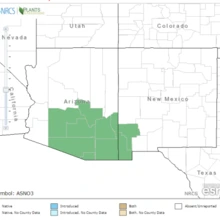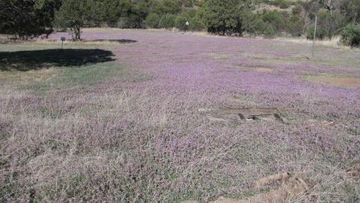Locoweed Information Guide
Astragalus is the largest genus of flowering plants in Arizona, with over 70 species, plus 2 species of Oxytropis, a species that closely resembles locoweed in both appearance and poisonous principle (Ruyle 2008).
There are some 352 species, 198 varieties, and 552 total taxa in North America north of Mexico (Welsh et al. 2007). Locoweed (also crazyweed or loco) are common North American plants that produce phytotoxins, nitro toxins, and selenium accumulation that are harmful to livestock. Typical symptoms of locoism occur from poisoning by the alkaloid, swainsonine. Worldwide, swainsonine is produced by a small number of species, most in three genera of the flowering plant family Fabaceae: Oxytropis and Astragalus in North America, and Swainsona in Australia. Locoweed is relatively palatable during some seasons of the year to livestock, and some individuals will seek it out. Livestock poisoned by chronic ingestion of large amounts of swainsonine develop a condition known as locoism and reported most often in cattle, sheep and horses.
The United States Department of Agriculture–Agricultural Research Service and New Mexico State University scientists have been collaborating since 1990 to help solve the problem that locoweed presents to livestock farmers. The research involved identifying the fungal species that produces the locoweed toxins, pinpointing levels of toxicity in animals once they have ingested locoweed, observing the effects of locoweed toxins on livestock’s reproduction and grazing preferences, etc. Common in southern Arizona and northern Mexico is the locoweed species, Astragalus nothoxys. This report will dialog this species by providing distribution and a botanical description as well as provide additional information regarding swainsonine poisoning and discuss some grazing management strategies observed in scientific literature. Appendix 1 contains photographs of Astragalus nothoxys.Astragalus nothoxys
Astragalus nothoxys Distribution and Habitat
Astragalus nothoxys is found in southeastern Arizona and adjoining Mexico and New Mexico (Figure 1).

This plant lies nearly prostrate, often covering 2 feet in diameter. It is abundant in the foothills (from 5,000-6,000 ft. in altitude) in the Santa Catalina, Santa Rita, Huachuca, and Chiricahua mountains, and as far north as Mt. Graham (Marsh et al.1936). Locoweeds are prolific seed producers (~ 4,000 seeds/m2) with seeds that remain viable for multiple years due to a hard seed exterior. These persistent seeds are an ecological advantage that allows seeds to remain dormant until conditions are favorable for germination and establishment (Cook et al. 2009). Populations of almost all locoweed species cycle as they typically increase during wet years and die back during drought (Cook et al. 2009; Ralphs and Stegelmeier 2011).
Botanical Description
Densely leafy plants growing typically in the Santa Catalina mountains; plants perennial; stems a foot long or longer, very numerous entire plant about glabrate; leaves with petioles varying widely in length, the upper ones occasionally sessile; leaflets 10-16, about 6mm long generally, ovate or obovate to elliptical, retuse, a-bit leathery, the pubescence sparse and villous; calyx almost cylindrical, about 4 mm long, straight below, arched above, the almost filiform teeth less than the tube; corollas dirty-white, purple-tinged; pods acute, about 2-celled, dorsally sulcate, erect, linear, or slightly broader, often arcuate, flattened laterally. Blooming in spring (Skora 1936).
Swainsonine Poisoning and Locoism
The toxin in Astragalus nothoxys is an alkaloid known as swainsonine. This toxin was first identified in a legume from Australia, Swainsona canescens, which causes a similar disease to locoism, pea struck (Cook et al. 2009). Locoism is a chronic poisoning. Animals must eat locoweed over extended periods to become poisoned. Locoweed poisoning has a subtle progression with few initial signs, eventually progressing to severe behavioral disorders (Cook et al 2009). Astragalus nothoxys, among many other species of Astragalus, produce swainsonine as their primary toxic compound, however nearly all of the genus carry more than one toxin.
The chronic ingestion of swainsonine causes a number of different problems (Cornell University Department of Animal Science website):
- Locoism
- Birth defects
- Reproductive problems
- Congestive heart failure
- Edema
- Growth retardation
- Loss of body condition
- Aggression
- Hyperactivity Stiff and clumsy gait
- Low head carriage
Clinical signs of poisoning develop after several weeks of chronic ingestion. When livestock begin to eat locoweed, some animals may temporarily do well. However, within 14 days poisoned animals become reluctant to move, lose their appetite, and subtle tremors are visible when they move. The clinical signs of locoism include (Cornell University Department of Animal Science website):
- Aggression
- Hyperactivity
- Stiff and clumsy gait
- Low head carriage
- Salivation
- Seizures
- Apparent blindness
- Increasing incoordination, weakness, and death
Reproductive loss is the greatest economic cost associated with locoweed poisoning. Locoweeds negatively affect almost every aspect of reproduction in livestock. The effects of locoweeds on female reproduction are abnormal pituitary and ovarian function, delayed estrus, lengthened estrus cycles, altered oogenesis, delayed placentation, reduced placental and uterine vascular development, water belly (a reproductive abnormality, and abortion (Cook et al. 2009).
Offspring that go to full term may be born small and weak and death rates are high (Ralphs and Stegelmeier 2011). Skeletal deformities, low vigor, and retardation in newborn animals are observed. Locoweeds affect male reproduction by reducing their libido and altering spermatogenesis. Most reproductive alterations are reversible; however, they can significantly impact livestock’s reproductive fitness (Cook et al. 2009).
Grazing Management with Locoweed Presence
The most effective management strategy to prevent poisoning is to deny livestock access to locoweeds during critical periods when they are more palatable than associated forage. Cattle on rangeland year-round should be removed from locoweed-infested sites in the spring when locoweed is green and growing, and warm-season grasses remain dormant. They can be returned to locoweed-infested areas in summer when warm-season grasses are growing and abundant (Ralphs and Stegelmeier 2011). However, horses are uniquely sensitive to poisoning and may eat toxic doses even when other forages are available.

Jim Koweek, rangeland consultant, AZ Re-veg
Many minerals and feed additives have been explored to prevent locoweed poisoning but none have proven to be effective. Poisonous plant literature is filled with statements that native livestock are less likely to be poisoned than new, inexperienced livestock however, locoweed poisoning does not follow this trend. Cattle that are familiar with locoweed will likely select it first (Ralphs et al. 1987) generally preferring the green-growing locoweeds to other forage that is dormant in fall, winter, and spring (Ralphs and Stegelmeier 2011).
Reserving locoweed-free pastures or controlling existing locoweed populations with herbicides can provide “safe” pastures for critical periods. Cook et al. (2009) describe a number of different grazing management recommendations that include a) restricting access, b) understocking in locoweed-infested areas, c) sorting out individuals that seek out locoweeds, d) herbicide control, and e) training locoweed aversion. Watching animals closely and removing those that begin eating locoweed can prevent further intoxication and prevent animals from influencing others to start. Good range management and wise grazing strategies can provide adequate forage for livestock and prevent them from grazing locoweed during critical periods when it is palatable (Panter et al. 1999; Ralphs and Stegelmeier 2011).
Cited literature
- Cook, D., Ralphs, M., Welch, K., & Stegelmeier, B. 2009. Locoweed poisoning in livestock. Rangelands, 31(1), 16-21.
- Cornell University Department of Animal Science website. Toxicity of Astragalus genus. Accessed April 8, 2015.
- Marsh, C. D., Clawson, A. B., & Eggleston, W. W. 1936. The loco weed disease (No. 1054). US Dept. of Agriculture.
- Panter, K.E., L.F. James, B.L. Stegelmeier, et al. 1999. Locoweeds: effects on reproduction in livestock. Journal of Natural Toxins 8:53-62.
- Ralphs, M. H., Mickelsen, L. V., & Turner, D. L. (1987). Cattle grazing white locoweed: diet selection patterns of native and introduced cattle. Journal of Range Management 40(4), 333-335.
- Ralphs, M. H., & Stegelmeier, B. L. 2011. Locoweed toxicity, ecology, control, and management. International Journal of Poisonous Plant Research, 1, 47-64.
- Ruyle, G.B. 2008. Locoweeds. University of Arizona Cooperative Extension publication Backyards and Beyond: Rural Living in Arizona(link is external), 2(1), 11. Accessed April 14, 2015.
- Skora, G. W. (1936). The species of Astragalus occurring in Arizona. Thesis, University of Arizona. SEINet data portal. Astragalus nothoxys search. Accessed April 7, 2015.
- USDA PLANTS Database. Astragalus nothoxys search. Accessed April 7, 2015.
- USDA Agricultural Research Service. Locoweed (Astragalus and Oxytropis spp.). Accessed April 14, 2015.
- Welsh, S. L., Ralphs, M. H., Panter, K. E., Pfister, J. A., James, L. F., & Wierenga, T. L. 2007. Locoweeds of North America: taxonomy and toxicity. Poisonous plants: global research and solutions, 20-29.

